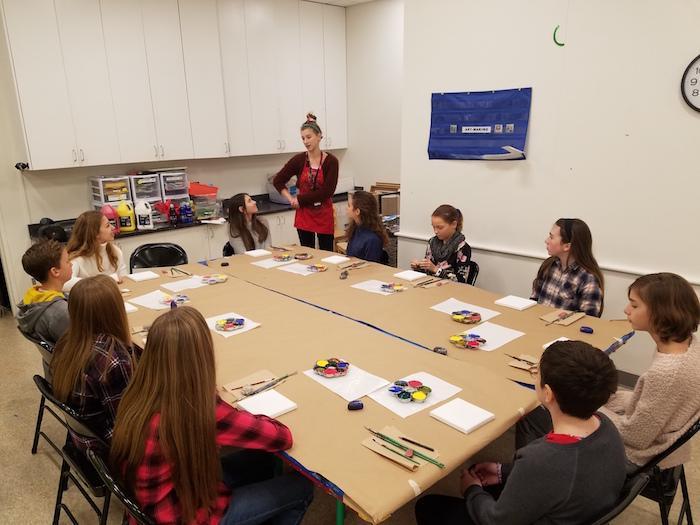February 1, 2019
Good day Masters, Mistresses, and Sirs,
We finished our Renaissance unit with a bang. The “Wax Museum” we held went well and the middle schoolers had amazing performances. For the past three weeks the middle school researched, wrote, sewed, painted, and memorized. Each member of the class chose an important Renaissance figure to become for the museum. The project had four parts: the essay on an assigned Renaissance figure, a speech where students became the people they learned about, a backdrop, and a costume of your figure.
Last week the class performed their speeches for upper elementary students, middle school parents, and other interested guests.
The Cast:
Queen Elizabeth the First — Izzy
Leonardo da Vinci — Kristalia
Niccolò Machiavelli— Maddie
Albrecht Durer— Hadley
Isaac Newton— Max
William Shakespeare— Lili
Michelangelo— Delia
Petrarch— Juliana
Brunelleschi— Sydney
Gutenberg— Ciel
Trip to the Museum of Fine Arts
Last week we also had a field trip to Boston to see Renaissance and medieval pieces at the Boston Museum of Fine Arts. We learned about the differences in the styles of painting and sculpture between the different times. We saw a cabinet with tortoiseshell and designs made for coral, an old clock that can tell the date, year, time, and zodiac, and a wall of a church that is hundreds of years old. The wall had beautiful paintings and really gave you a glimpse of what the lives were like during that time. There were also many paintings having to do with religion, royalty, and myth. It was interesting to see that once the Renaissance or the age of art began to blossom, you could truly see perspective, shading, shadowing, and realism show in these artworks.
After our tour we made some paintings of our own. We incorporated reoccurring designs we had seen an artwork from the Renaissance and created our own paintings. After lunch the alarm at the museum went off and we evacuated the building. Our train back to Rhode Island would not leave for another hour so we wandered around looking for a place to sit down and warm up form the cold weather we were in. It was a cold day but it was nice to see the campus of Northeastern, and we made it back to the train station in plenty of time. 
AMS Peace Grant
In other exciting news, we have been awarded a peace grant from American Montessori Society (AMS). The grant is $500 and will support the work and studies from this year and plan to implement in the future. This is an amazing opportunity and can only help the Middle School and our quest for peace.
Science ROV Study
This week the middle school started our next science unit. This unit will be about ROVs (Remotely Operated Vehicles)! ROVs are used for underwater exploration and research. They take videos, collect samples of water and sea plants, and perform all types of research. We will be designing our own. The process will include making the ROV, making the propulsion system, making a control, and testing the ROVs in the URI pool.
As part of our science work we learned about mass, volume, and density. The exercise was to find the mass, volume, and density of ten objects and then create a table. The exercise showed us that an object that has a density less than one would float and any density that had more than one would sink, but if the density was one the object would “flink.”
To see buoyancy, gravity, and density in action we did two experiments. One was with two Coke cans, one diet and one original. The experiment showed that the diet coke floated and the original Coke sank because of the density of the liquid. Now there is a reason that the original Coke sank and why it is more dense than the Diet Coke. That reason is sugar. The dissolved sugar in the original Coke made the mass of the can more. The artificial sweetener found in the Diet Coke made it less dense than the water.
The second experiment was with paper clips and a styrofoam ball. The goal was to get the ball to stay at a neutrally buoyant stage or suspended in the middle for the water. The problem is that the ball would float unless it had more mass, that is where the paper clips come in. we had to find the right amount for clips to make the ball neutrally buoyant. It proved a challenge because once we had reached a certain amount of clips if we added one the ball would sink or become negatively buoyant and if we took one away the ball would float or be positively buoyant. The solution was cut a clip in half. Most or all the groups got their ball to be flink or be neutrally buoyant.
Thanks for reading along on another busy week!
Your Middle School Correspondent,
J. Coghlin



